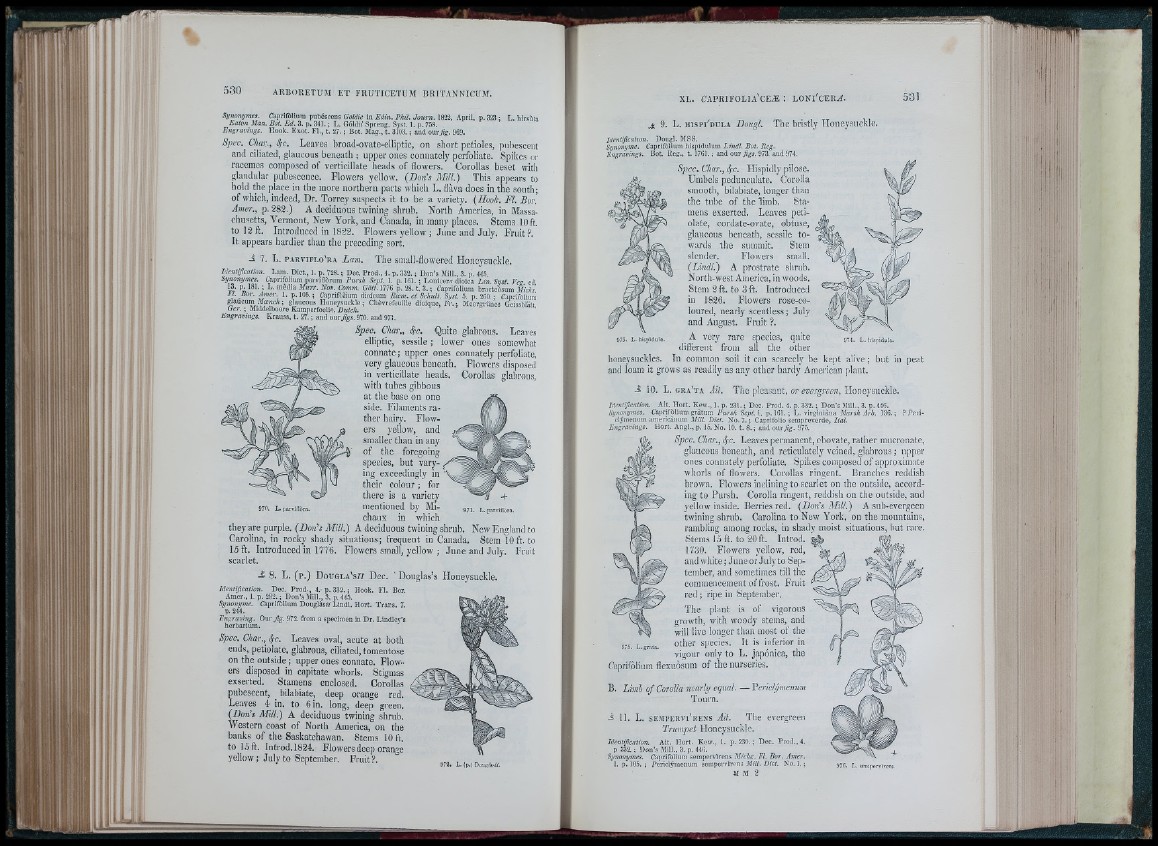
d .
Sipïonyines. CaprifWium pubéscens Goldie in Edin. Pkil. Journ. 1822, April, p. 323 : L. hirsùta
Eaton Man. Bot. Ed. 3. p. 341. ; L. GÓKiiì Spreng. Syst. 1. p.758. ’ ^ ^
Efigravings. Hook. Exot. Fl., t. 27. ; Bot. Mag., t. 3103. ; and ourßg. 969.
Spec. Char., 4c. Leaves broacl-ovate-elliptic, on short petioles, pubescent
and ciliated, glaucous beneath ; upper ones connately perfoliate. Spike.s or
racemes composed of verticillate heads of flowers. Corollas beset with
glandular pubescence. Flowers yellow. (Don’s Mill.) This apjiears to
hold the place in the more northern parts which L. flàva does in the south;
of which, indeed. Dr. Torrey su.spects it to be a variety. (Hook. Fl. Bor.
Amer., p. 282-) A deciduous twining shrub. North America, in Massa-
chu.setts, Vermont, New York, and Canada, in many places. Stems 10 ft.
to 12 ft. Introduced in 1822. Flowers yellow ; June and July. Fruit?.
It appears hardier than the preceding sort.
A 7. L. p a r v i f l o ' r a Lam. The small-flowered Honeysuckle.
Identification. Lam. Diet., 1. p. 728. ; Dec. Prod., 4. p. 332, ; Don’s Mill., 3. p. 44-5.
Synonymes. Capnfòlium parviflòrum Pursh Sept. 1. p. 161. ; Lonicera dioica Lin. Syst. Ves. cd.
Jj" ™èdia Murr. Nov. Comrn. Gott. 1776 p. 28. t. 3. ; Caprifòlium bracteòsum Michx
I I . Bor. Amer. 1. p. 105. ; Caprifììlium dioicum Roem. et Schult. Syst. 5. p. 2G0. : Capriiòlium
p^aucum Moenc ; glaucous Honeysuckle; Chèvrefeuille dioiqiie, F r .; Meergrünes Geissblatt
Gcr. ; Middelboore Kamperfoelie, Dutch. i » e
Engravings. Krauss, t. 27. ; and our figs. 970. and 971.
Spec.^ Char., 4c. Quite glabrous. Leaves
elliptic, sessile ; lower ones somewliat
connate ; upper ones connately perfoliate,
very glaucous beneath. Flowers disposed
in verticillate heads. Corollas glabrous,
with tubes gibbous
at the base on one
side. Filaments ra ther
hairy. Flowers
yellow, and
smaller than in any
of the foregoing
species, but vary- ^
ing exceedingly in ''
their colour ; for
there is a variety
mentioned by Michaux
in which
they are purple. (Don’s Mill.) A deciduous twining shrub. New England to
Carolina, in rocky shady situations; frequent in Canada. Stem 10 ft. to
15 ft. Introduced in 1776.
Flowers small, yellow ; June and July. Fruit
scarlet.
A 8 . L. (p.) D o u g l a ' s / / Dec. ' Douglas’s Honeysuckle.
Identification. Dec. Prod., 4.- p. 332.; Hook. Fl. Bor.
Amer., 1. p. 282.; Don’s Mill., 3. p. 445.
Synonyme. Caprifblium DougUs« Lindl. Hort. T ra rs . 7.
p. 244.
Engraving. Our Jig. 972. from a specimen in Dr. Lindley’s
herbarium.
Spec. Char.,^ 4c. Leaves oval, acute at both
ends, petiolate, glabrous, ciliated, tomentose
on the outside; upper ones connate. Flowers
disposed in capitate whorls. Stigmas
exserted. Stamens enclosed. Corollas
pubescent, bilabiate, deep orange red.
Leaves 4 in. to 6 in. long, deep green,
(Doris Millri) A deciduous twining shrub.
Western coast of North America, on tlie
banks of the Saskatchawan. Steins 10 ft.
to 15 ft. Introd.1824. Flowers deep orange
yeliow ; July to September. Fruit?. 973. L. (p.) I)ouB/asii.
X L . C A P R I F O L IA 'C E Æ : L O N l ' c E I l ^ .
Jk 9. L. h i s p i ' d u l a Dougl. The bristly Honeysuckle.
Dougl. MSS.
'aprifòlium hisp
Bot. Reg., t. 1761.; and
Identification.
Synonyme. Caprifò!
Engravings.
hispîdulum Lindl. Bot. Reg.
' ’ jîgs. 973, and 974,
973. L. hispidula.
honeysuckles-
Spec. Char., 4c. Hispidly pilose.
Umbels pedunculate. Corolla
smooth, bilabiate, longer than
the tube of the limb. Stamens
exserted. Leaves petiolate,
cordate-ovate, obtuse,
glaucous beneath, sessile towards
the summit. Stem
slender. Flowers small.
(Lindi.) A prostrate shrub.
North-west America, in woorls.
Stem 2 ft. to 3 ft. Introduced
in 1826. Flowers rose-coloured,
nearly scentless; July
and August. Fruit ?.
A very rare species, quite
different from all the other
Tn common soil it can scarcely be kept alive; but in peat
' II ;i
1(1 1
!; ft:
; h:'
i i f t f t l :
■ I" '
974. L. hispidula.
and loam it grows as readily as any other hardy American })lant,
A 10. L. g r.a 'ta Ait. The pleasant, 07’ <?ua;”gr<7i?7z. Honeysuckle.
Identification. Ait. Hort. Kew., 1. o. 231. ; Dec. Prod. 4. p. .332. ; Don’s Mili., 3. p. 446.
Synonymes. Caprifòlium gràtum Fursh Sept. \. p . 161.; L . virginiàna Marsh Arb. 136.; ?P o ii-
_dÿmeniim americànum Mül. Dict. No. 7. ; Caprifolio sempreverde, Ital.
Hort. Ángl., p. 15. No. 10. t. 8. ; and our fig. 975.
Spec. Char., 4c. Leaves permanent, obovate, rather mucronate,
glaucous beneath, and reticulately veined, glabrous ; upper
ones connately perfoliate. Spikes compo.sed of approximate
wiiorls of flowers. Corollas ringent. Branches reddish
brown. Flowers inclining to scarlet on the outside, according
to Pursh. Corolla ringent, reddish on the outside, and
yellow inside. Berries red. (Doris Mill.) A sub-evergeen
twining shrub. Carolina to New York, on the mountains,
rambling among rocks, in shady moist situations, but rare.
Stems 15 ft. to 20 ft. Introd.
1730. Flowers yellow, red,
and white ; June or July to September,
and sometimes till the
commencement of frost. Fruit
red ; ripe in September.
The plant is of vigorous
growth, with woody stems, and
will live longer than most of the
other sj)ecies. It is inferior in
vigour only to L. japónica, the
C’aprifòliura flexuòsum of the nurseries.
B. Limb of Corolla nearly equal. — 'Periclÿmenum
Tourn.
A 11. L. s e m p e r v i ' r e n s Ait. The evergreen
Trumpet Honeysuckle.
Identification. Ait. Hort. Kew., 1. p. 230. ; Dec. Prod., 4.
p 332. ; Don’s Mil!., 3. p. 446.
Synonymes. Caprifblium sempervìrens Michx. Fl. Bor. Amer.
1. p. 105. ; Pendymenum sempervìrens Mill. Bict. No, 1, ;
M M 2
57G. L. 8cmp«rv\rpn«